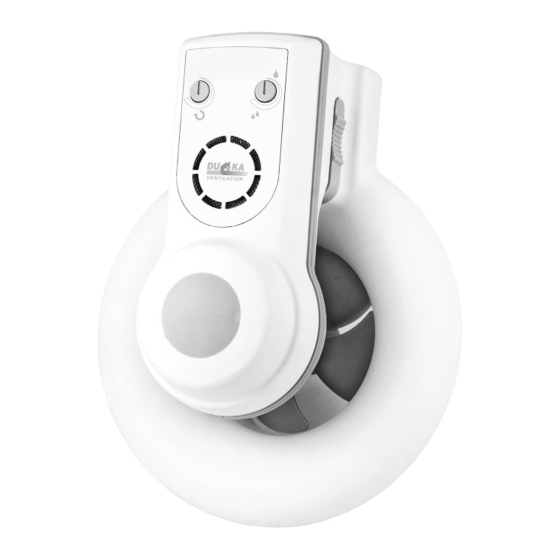Duka PRO 260 Manual de uso e instalación - Página 10
Navegue en línea o descargue pdf Manual de uso e instalación para Ventilador Duka PRO 260. Duka PRO 260 11 páginas.

UK - For the installer
Before using the fan, carefully read these instructions and the warranty conditions.
DUKA PRO 260 is designed for fixed installation and must be installed by a qualified electrician.
Fold out pages "III" and "IV" to the left and right respectively so that you can see all the
illustrations when reading the user and installation guide.
The PRO 260 exhaust fan is designed to boost the air flow in houses* with natural draught ventilation.
It is suitable for installation in wet rooms and can be installed in ducts with and without natural
ventilation**.
The fan fits ducts with a diameter of Ø or 100 – Ø 140 mm. For larger duct dimensions a cover
plate for the PRO-series must be used. To ensure that the PRO 260 does not affect other ventila-
tion systems and is not affected by them, the fan must always be installed in its own duct.
Make sure that the duct is clear of obstructions. Avoid insect mesh, filters and other objects that may
obstruct the flow of air. To prevent condensation in natural draught ducts (in winter), the ducts must
be insulated where they pass through unheated areas such a cold attics.
To avoid backdraughts in ducts without natural draught (eg through an external wall), a back-
draught shutter (see page II) can be retrofitted. This requires another ventilation system to handle
the basic ventilation flow of the building. NOTE: A backdraught shutter is harmful if the fan is
installed in a ventilation duct with natural ventilation.
The fan is designed for use in a temperature range of 5 to 35 °C. If the fan is installed in a cold area
or if it has been stored in a cold place before installation, it may run slowly when started for the first
time. The fan will work normally when it reaches its working temperature.
installation
Push the two locking buttons towards the centre (A1) and lift the motor unit out of the frame (see
Figure A). Then remove the motor unit (A2).
Unscrew screw E1 and remove the housing from the frame (see Figure E). The terminal block (E2) is
behind the frame.
The fan may be installed in any position.
The seal supplied (see Figure G) is in three parts: gasket, cuff and cable gland. Separate these from
each other.
Install the gasket (see Figure H). Note that the gasket also serves as a bushing for the screws. For a
concealed electrical connection, install the cable gland in one of the three knockout openings (H1).
The cable gland must be used for surface electrical connection as well. For this, a breakaway section
in the housing must be removed (see Figure J).
The rubber gasket should be used for assembly in the ceiling, Ø 100 mm pipe (see Figure K).
12
Secure the frame to the structure with the four screws (see Figure F). The inner holes (F1) have the
same hole pattern as the EL 200 series fans. This makes it easier to change to a PRO-series fan.
The outer holes (F2) are used if the size of the duct limits the space available for firm fixing. (If there
is not enough space for screw fixing, we recommend installing a PRO cover plate.
Do not forget the screw (F3) under the terminal block. It is used to adjust the fan with respect
to the structure so that the impeller is centred in the frame.
Connect in accordance with the wiring diagram. See under Connection below.
Make sure that the housing snaps into place properly when it is fitted to the frame (Figure L).
Tighten the screw (E1). Refit the motor unit to the frame.
Test the humidity sensor by first turning the control (C2) clockwise until the fan starts. Then turn
the control slowly anticlockwise until the fan stops. Leave the control in this position.
Turn the presence sensor control clockwise to the desired operating position (C1).
ConneCtion
The PRO 260 has stepless speed control to control the basic ventilation flow. It also has functions
for automatic forcing to maximum speed with the humidity is high and manually with a switch.
Check with the user which of the functions below (apart from S1) the user requires.
• S1: basic ventilation and automatic forcing to maximum speed when the humidity is high.
• S2: As S1, as well as forcing to maximum speed for a 15-minute timer function via a light
switch or a separate switch.
• S3: As for S2 but in combination with lighting.
• S4: As for S3 but with direct starting via a light switch or a separate switch.
The fan is designed for 230V AC (± 10%) ~50Hz. It is double-insulated and must not be grounded.
According to the standard for domestic products, EN60 335-1, it must be possible to isolate such products
from the electric power supply. One way to do this is to use a switch with an approved isolation gap.
The fan must be isolated from the electric power supply for all work on the product.
S
S1
S3
Hand this user and installation guide to the user when the installation is complete.
UK - For the installer
S2
S4
13
